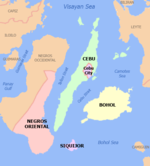Tagbilaran
Tagbilaran | |
|---|---|
| City of Tagbilaran | |
 Tagbilaran, Bohol | |
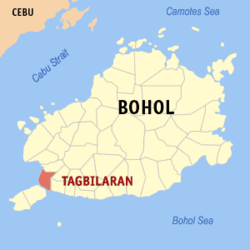 Map of Bohol with Tagbilaran highlighted | |
Location within the Philippines | |
| Coordinates: 9°39′N 123°51′E / 9.65°N 123.85°E | |
| Country | Philippines |
| Region | Central Visayas |
| Province | Bohol |
| District | 1st district |
| Incorporated • Municipality • City | 9 February 1742 1 July 1966 |
| Barangays | 15 (see Barangays) |
| Government | |
| • Type | Sangguniang Panlungsod |
| • Mayor | Jane Censoria Cajes-Yap |
| • Vice Mayor | Adam Relson L. Jala |
| • Representative | Edgardo M. Chatto |
| • City Council | Members |
| • Electorate | 70,254 voters (2022) |
| Area | |
| • Total | 36.50 km2 (14.09 sq mi) |
| Elevation | 39 m (128 ft) |
| Highest elevation | 449 m (1,473 ft) |
| Lowest elevation | 0 m (0 ft) |
| Population (2020 census)[3] | |
| • Total | 104,976 |
| • Density | 2,900/km2 (7,400/sq mi) |
| • Households | 23,078 |
| Economy | |
| • Income class | 3rd city income class |
| • Poverty incidence | 10.46 |
| • Revenue | ₱ 985.1 million (2020) |
| • Assets | ₱ 2,634 million (2020) |
| • Expenditure | ₱ 939.7 million (2020) |
| • Liabilities | ₱ 512.8 million (2020) |
| Service provider | |
| • Electricity | Bohol Light Company (BLCI) |
| Time zone | UTC+8 (PST) |
| ZIP code | 6300 |
| PSGC | |
| IDD : area code | +63 (0)38 |
| Native languages | Boholano dialect Cebuano Tagalog |
| Website | tagbilaran |
Tagbilaran, officially known as the City of Tagbilaran (Cebuano: Dakbayan sa Tagbilaran), is a 3rd class component city and capital of the province of Bohol, Philippines. According to the 2020 census, it has a population of 104,976 people.[3]
Encompassing a land area of 32.7 km2 (12.6 sq mi), with a coastline of 13 km (8.1 mi) on the southwestern part of the island, the city shares its boundaries with the towns of Cortes, Corella, and Baclayon.
Tagbilaran is the principal gateway to Bohol, 630 km (390 mi) southeast of the national capital of Manila and 72 km (45 mi) south of the regional capital, Cebu City.[5]
Etymology
According to oral tradition, the name is a Hispanicized form of "Tagubilaan", a compound of tagu, meaning "to hide" and "Bilaan", referring to the Blaan people, who were said to have raided the Visayan Islands. This explanation seems to correlate with the government's explanation. According to the official government website of Tagbilaran, it is said to have been derived from tinabilan meaning shielded, as the town was protected by Panglao from potential invaders.[6]
History
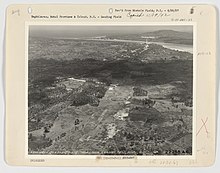


A hundred years before Spaniards arrived in the Philippines, the settlement which eventually became Tagbilaran was already involved in trading with China and Malaya. Tagbilaran Strait was the location of the Precolonial kingdom of the Kedatuan of Dapitan. This early settlement had contact with the Spaniards in 1565, when the Spanish conquistador Miguel López de Legazpi and the native chieftain Datu Sikatuna pledged peace and cooperation through the famous blood compact.
(San Jose de) Tagbilaran was established as a town on February 9, 1742, by General Don Francisco Antonio Calderón de la Barca, Governor of the Visayas, who separated it from the town of Baclayon. The town was dedicated to St. Joseph the Worker. Since then it was part of the province of Bohol until it became a chartered city on July 1, 1966, by virtue of Republic Act No. 4660.
The city was occupied by the United States during the Philippine–American War and by Imperial Japan during World War II.
Sitio Ubos (Lower Town) is Tagbilaran's former harbor site and is considered to be the city's oldest portion, having been a busy trading center since the seventeenth century until the early twentieth century. As such, the place houses the oldest and largest number of heritage houses in Bohol. Sitio Ubos declined as a major port towards the end of the Spanish era when the causeway to Panglao Island was constructed. Since then, the area lost its former glory and its old houses were either demolished or neglected.[7]
In 2002, in recognition of its cultural and historic significance, Sitio Ubos was declared a "Cultural Heritage Area". Some of the surviving heritage houses to this day include the Rocha–Suarez House, Rocha House, Hontanosas House, Beldia House, and Yap House.[7]
Historic events
One of the most important events in Philippine history (immortalized on canvas by the famous Filipino painter Juan Luna) was the blood compact between Datu Sikatuna, a local native chieftain, and Captain Miguel López de Legazpi, the Spanish explorer and colonizer. It took place in the coast of Bool, now a district of Tagbilaran, on March 16, 1565, a day after Legazpi and his crew of conquistadores on four ships chanced upon the shores of Bool during their trip to the province of Butuan from Camiguin Island because of strong southwest monsoon winds and low tide.
On that day, March 16, 1565, Legazpi with Fray Andres de Urdaneta and some of his crew set foot on land for an audience with the local chieftain Sikatuna. The two bands of different race and creed met a few hundred meters from the beach and, after a few pleasantries, the Basque seafarer and the chieftain of Bohol sealed and strengthened their treaty of friendship in a historic blood compact. Sikatuna and Legazpi each made a cut on the left arm and collected the drop of blood into a single vessel mixed with wine. A marker now stands on the spot where Sikatuna and Legaspi allegedly sealed that famous compact.[a] To honor this treaty of friendship, president Elpidio Quirino established the "Order of Sikatuna" in 1953, a presidential award and decoration conferred upon visiting dignitaries.
Tagbilaran was occupied by Imperial Japanese forces on May 17, 1942, after the fall of the Philippines during World War II.
During the Japanese occupation, the municipal government of Tagbilaran, whose mayor at the time was Manuel Espuelas, moved from the Poblacion to Tiptip.[8] Another significant event was the Battle of Ubujan wherein a guerrilla unit under the command of Captain Francisco Salazar (aka Vicente Cubello) engaged Japanese troops against overwhelming odds.[9]
2013 earthquake
An earthquake with magnitude 7.2, with an epicenter near Sagbayan, Bohol, struck Bohol on October 15, 2013. Tagbilaran received four fatalities and 21 injuries, and damage to buildings, including the seaport, airport, and city hall.
Geographic
Climate
| Climate data for Tagbilaran City (1981–2010) | |||||||||||||
|---|---|---|---|---|---|---|---|---|---|---|---|---|---|
| Month | Jan | Feb | Mar | Apr | May | Jun | Jul | Aug | Sep | Oct | Nov | Dec | Year |
| Mean daily maximum °C (°F) | 31.1 (88.0) |
31.6 (88.9) |
32.4 (90.3) |
33.3 (91.9) |
33.5 (92.3) |
32.9 (91.2) |
32.5 (90.5) |
32.8 (91.0) |
32.8 (91.0) |
32.4 (90.3) |
32.0 (89.6) |
31.4 (88.5) |
32.4 (90.3) |
| Daily mean °C (°F) | 26.8 (80.2) |
27.1 (80.8) |
27.6 (81.7) |
28.5 (83.3) |
29.0 (84.2) |
28.7 (83.7) |
28.4 (83.1) |
28.7 (83.7) |
28.6 (83.5) |
28.2 (82.8) |
27.8 (82.0) |
27.2 (81.0) |
28.0 (82.4) |
| Mean daily minimum °C (°F) | 22.6 (72.7) |
22.5 (72.5) |
22.8 (73.0) |
23.6 (74.5) |
24.4 (75.9) |
24.4 (75.9) |
24.3 (75.7) |
24.5 (76.1) |
24.4 (75.9) |
24.0 (75.2) |
23.6 (74.5) |
23.0 (73.4) |
23.7 (74.7) |
| Average rainfall mm (inches) | 101.0 (3.98) |
79.6 (3.13) |
76.6 (3.02) |
67.5 (2.66) |
81.5 (3.21) |
128.2 (5.05) |
126.7 (4.99) |
116.3 (4.58) |
126.5 (4.98) |
176.3 (6.94) |
178.9 (7.04) |
153.6 (6.05) |
1,412.6 (55.61) |
| Average rainy days (≥ 0.1 mm) | 14 | 11 | 11 | 9 | 10 | 15 | 15 | 13 | 14 | 18 | 18 | 16 | 164 |
| Average relative humidity (%) | 83 | 81 | 79 | 78 | 79 | 81 | 82 | 80 | 81 | 83 | 85 | 84 | 81 |
| Source: PAGASA[10] | |||||||||||||
Barangays
There are 15 barangays comprising Tagbilaran, with a population of 104,976 for the year 2020 census,[3] and an annual growth rate of 1.56%. However, 44% of the city's population reside in the four urban districts where trade and commerce are also concentrated.
|
| |||||||||||||||||||||||||||||||||||||||||||||||||||||||||||||||||||||||||||||||||||||||||||||||||||||||||||||||||||||||||||||||||||||||||||||||||||||||||||||||||||||||||||||||||||||||||||||||||||||||
Demographics
| Year | Pop. | ±% p.a. |
|---|---|---|
| 1903 | 10,108 | — |
| 1918 | 12,305 | +1.32% |
| 1939 | 15,617 | +1.14% |
| 1948 | 16,051 | +0.31% |
| 1960 | 20,250 | +1.96% |
| 1970 | 33,005 | +5.00% |
| 1975 | 37,335 | +2.50% |
| 1980 | 42,683 | +2.71% |
| 1990 | 56,363 | +2.82% |
| 1995 | 66,683 | +3.20% |
| 2000 | 77,700 | +3.33% |
| 2007 | 92,297 | +2.40% |
| 2010 | 96,792 | +1.75% |
| 2015 | 105,051 | +1.57% |
| 2020 | 104,976 | −0.01% |
| Source: Philippine Statistics Authority[12][11][13] | ||
Economy
Poverty incidence of Tagbilaran
2.5
5
7.5
10
12.5
15
2006
10.40 2009
11.02 2012
7.85 2015
8.69 2018
3.40 2021
10.46 Source: Philippine Statistics Authority[14][15][16][17][18][19][20][21] |

The city has the advantage of being the province's main business capital and center of governance, education and transportation. Local and international visitors to Bohol pass through the city via the Port of Tagbilaran.
Alturas Group (operator of Alturas Mall, Island City Mall and Plaza Marcela), Bohol Quality Corporation and Alvarez Group are some of the notable locally owned companies based in the city.
Government
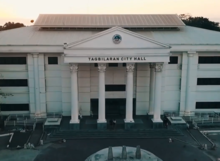
Chief Executives since 1742
The city is governed locally by a mayor, although historically by a gobernadorcillo and presidente municipal afterwards.
| Chief Executives of Tagbilaran since 1742 | |||
|---|---|---|---|
| Term | Title | Name | |
| Gobernadorcillo | Calixto Marcos | ||
| Sector Leader of Dagohoy | Calixto Sotero | ||
| unknown | Gobernadorcillo | Martin Flores | |
| unknown | Gobernadorcillo | Manuel de la Peña | |
| Gobernadorcillo | Leonardo Guillermo | ||
| Gobernadorcillo | Leon Torralba | ||
| Gobernadorcillo | Francisco Reales | ||
| Gobernadorcillo | Esteban Butalid | ||
| Gobernadorcillo | Alejandro Fama | ||
| Gobernadorcillo | Pedro Matig‑a | ||
| Gobernadorcillo | Felipe Rocha | ||
| Gobernadorcillo | Jacinto Borja y Borja | ||
| Gobernadorcillo | Flaviano Ramirez | ||
| Gobernadorcillo | Manuel Miñoza | ||
| Gobernadorcillo | Eduardo Calceta | ||
| Presidente Municipal | Salustiano Borja | ||
| Presidente Municipal | Margarito Torralba | ||
| Presidente Municipal | Claudio Gallares | ||
| Presidente Municipal | Anecito Clarin | ||
| Presidente Municipal | Macario Sarmiento | ||
| Presidente Municipal | Servando Matig‑a | ||
| Presidente Municipal | Mariano Parras | ||
| Presidente Municipal | Margarito Torralba | ||
| Presidente Municipal | Gaudencio Mendoza | ||
| Presidente Municipal | Lorenzo Torralba | ||
| Presidente | Felipe Sarmiento | ||
| Presidente | Miguel Parras | ||
| Presidente | Nicolas Butalid | ||
| Presidente | Celestino Gallares | ||
| Presidente | Jacinto Remolador | ||
| Presidente | Gregorio Peñaflor | ||
| Presidente | Felipe Sarmiento | ||
| Presidente | Timoteo Butalid | ||
| Presidente | Andres Torralba | ||
| Presidente | Genaro Visarra | ||
| Municipal Mayor | Honorio Grupo | ||
| Municipal Mayor | Manuel Espuelas | ||
| Municipal Mayor | Mariano Rocha | ||
| Municipal Mayor | Manuel Espuelas | ||
| Municipal Mayor | Honorio Grupo | ||
| Municipal Mayor | Pedro Belderol | ||
| Municipal/City Mayor | Venancio Inting | ||
| City Mayor | Rolando Butalid | ||
| City Mayor | Jose Ma. Rocha | ||
| OIC City Mayor | Dan Lim | ||
| OIC City Mayor | Jose Torralba | ||
| OIC City Mayor | Carmen Gatal | ||
| OIC City Mayor | Bonifacio Libay | ||
| OIC City Mayor | Ismael Villamor | ||
| City Mayor | Jose Torralba | ||
| City Mayor | Jose Ma. Rocha | ||
| City Mayor | Jose Torralba | ||
| City Mayor | Dan Lim | ||
| City Mayor | John Geesnell Yap | ||
| City Mayor | Jane Censoria Cajes-Yap | ||
Tourism

The city is a start-off point to Bohol province's attractions: the Chocolate Hills, tarsiers, white sandy beaches, dive spots, heritage sites and old stone churches. Home to several hotels, resorts, and restaurants, the city has recently become a venue for national conventions and gatherings.
Festivals
'Saulog-Tagbilaran Festival is a celebration every April 20 to May 2. This includes street-dancing, fluvial procession, nightly activities, novena masses and beauty pageant. Tagbilaranon families invite relatives and friends for a lunch or dinner during desperas (visper) and katumanan (grand feast day May 1).
The Sandugo Festival is an annual celebration in Tagbilaran in commemoration of the blood compact between Miguel López de Legazpi and Datu Sikatuna in March 1565. The festival is celebrated every July to coincide with the month-long activities celebrating the city's Charter Day on July 1 and the Province's (Bohol) Day on July 22.
Transportation

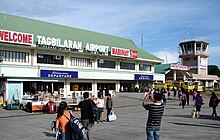
Tagbilaran's land network consists of sealed and unsealed roads. Local transport plying the routes within the city are tricycles, multicabs, taxis, and jeepneys. Buses, taxis and vans are usually hired for out-of-town travel. The Integrated Bus Terminal (IBT) located in the city district of Dao serves as the terminal point for public transport vehicles serving the inter-city routes within the province and also serves as the embarkation point for passengers taking the Pan-Philippine Highway (AH26) bus route from Tagbilaran to Metro Manila. There is also a long-distance bus station within Cogon market.
The city is linked by sea to the major port cities in the Visayas Islands and Mindanao, which of major commercial importance is its link to the regional capital of Cebu City. A fastcraft ferry ride to Cebu City's Pier 1 takes approximately 2 hours depending on weather and sea conditions.[22] The route is served by Ocean Jet, Weesam Express and SuperCat several times daily.
Bohol-Panglao International Airport is situated at the Panglao Island southwest of the city. It replaced Tagbilaran Airport on November 27, 2018.[23] It serves as the principal gateway airport to the rest of the province. Airlines using the airport serve primarily the Tagbilaran-Manila route, Tagbilaran-Clark route, and also Mindanao. The route is served by Cebu Pacific Air, Cebgo, PAL Express, and AirAsia Philippines using Airbus A319, Airbus A320 and ATR 72 planes. Flight time to Manila is approximately 1h:15.
Healthcare
The city is served with a mix of public and private health care institutions that also cater to the health needs of the rest of the province. Complex major cases and services are sent to nearby Cebu City due to limited facilities.
-
- Holy Name University Medical Center Foundation, Inc.
- Borja Family Hospital Corporation
- Englewood Hospital
- Governor Celestino Gallares Memorial Regional Hospital (tertiary public)
- MMG Bohol Cooperative Hospital
- Ramiro Community Hospital (tertiary private)
- Bohol St. Jude General Hospital
- Tagbilaran Community Hospital
- Tagbilaran Maternity and Children's Hospital
Education
As the capital of Bohol, Tagbilaran is the main center for education in the province. All of the province's universities are located in the city as well as other well-known institutions of learning.
-
- ACLC College of Tagbilaran
- Bohol Island State University (BISU)
- BIT International College (BIT-IC, formerly Bohol Institute of Technology (BIT))
- Bohol Technical Institute (BTI)
- Bohol Wisdom School
- Cristal e-College
- Holy Name University
- Holy Spirit School of Tagbilaran
- Immaculate Heart of Mary Seminary (IHMS)
- PMI Colleges Bohol
- University of Bohol
Notable personalities
- Mark Magsayo – Boxer
- José Abueva – Academician
- Napoleon Abueva – Artist
- Czar Amonsot – Boxer
- Rich Asuncion – Starstruck Finalist/TV Actress
- Maxelende Ganade – Singer-songwriter
- Luke Mejares – TV Personality/Singer
- Cecilio Putong – Secretary of Education (1952)
- Nestor Principe - Martial arts instructor and activist martyred during the Marcos dictatorship and honored at the Bantayog ng mga Bayani
- Marco Sison – Singer
- Fermin Torralba – Secretary of the Philippine Senate (1931–1935)
- Isagani Yambot – Journalist
- Vanessa Sarno – Medalist, Weightlifting
Notes
References
- ^ City of Tagbilaran | (DILG)
- ^ "2015 Census of Population, Report No. 3 – Population, Land Area, and Population Density" (PDF). Philippine Statistics Authority. Quezon City, Philippines. August 2016. ISSN 0117-1453. Archived (PDF) from the original on May 25, 2021. Retrieved July 16, 2021.
- ^ a b c d Census of Population (2020). "Region VII (Central Visayas)". Total Population by Province, City, Municipality and Barangay. Philippine Statistics Authority. Retrieved July 8, 2021.
- ^ "PSA Releases the 2021 City and Municipal Level Poverty Estimates". Philippine Statistics Authority. April 2, 2024. Retrieved April 28, 2024.
- ^ "Tagbiliran". Value Alliance. Retrieved January 30, 2019.
- ^ "History".
- ^ a b Akpenodu & Saloma 2011.
- ^ "Historical and Cultural Life of the Barrio of Tiptip". National Library of the Philippines Digital Library. Retrieved January 21, 2017.
- ^ History of Tagbilaran Retrieved December 6, 2009.
- ^ "Tagbilaran City, Bohol Climatological Normal Values". Philippine Atmospheric, Geophysical and Astronomical Services Administration. Archived from the original on October 18, 2018. Retrieved October 18, 2018.
- ^ a b Census of Population and Housing (2010). "Region VII (Central Visayas)" (PDF). Total Population by Province, City, Municipality and Barangay. National Statistics Office. Retrieved June 29, 2016.
- ^ Census of Population (2015). "Region VII (Central Visayas)". Total Population by Province, City, Municipality and Barangay. Philippine Statistics Authority. Retrieved June 20, 2016.
- ^ Censuses of Population (1903–2007). "Region VII (Central Visayas)". Table 1. Population Enumerated in Various Censuses by Province/Highly Urbanized City: 1903 to 2007. National Statistics Office.
- ^ "Poverty incidence (PI):". Philippine Statistics Authority. Retrieved December 28, 2020.
- ^ "Estimation of Local Poverty in the Philippines" (PDF). Philippine Statistics Authority. November 29, 2005.
- ^ "2003 City and Municipal Level Poverty Estimates" (PDF). Philippine Statistics Authority. March 23, 2009.
- ^ "City and Municipal Level Poverty Estimates; 2006 and 2009" (PDF). Philippine Statistics Authority. August 3, 2012.
- ^ "2012 Municipal and City Level Poverty Estimates" (PDF). Philippine Statistics Authority. May 31, 2016.
- ^ "Municipal and City Level Small Area Poverty Estimates; 2009, 2012 and 2015". Philippine Statistics Authority. July 10, 2019.
- ^ "PSA Releases the 2018 Municipal and City Level Poverty Estimates". Philippine Statistics Authority. December 15, 2021. Retrieved January 22, 2022.
- ^ "PSA Releases the 2021 City and Municipal Level Poverty Estimates". Philippine Statistics Authority. April 2, 2024. Retrieved April 28, 2024.
- ^ "Cebu to Bohol". GeckoRoutes. September 19, 2019. Retrieved October 4, 2019.
- ^ Rey, Aika (November 27, 2018). "Duterte inaugurates Bohol-Panglao International Airport". Rappler. Retrieved October 4, 2019.
Sources
- Akpenodu, Erik; Saloma, Czarina (2011). Casa Boholana: Vintage Houses of Bohol. Manila: Ateneo de Manila UP. ISBN 978-9715506182.







